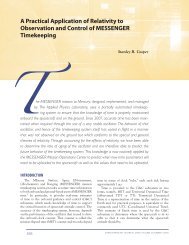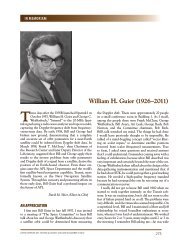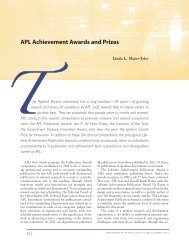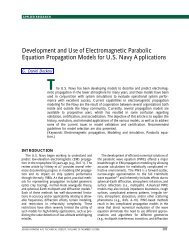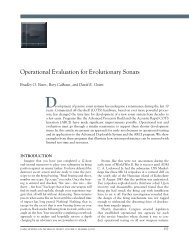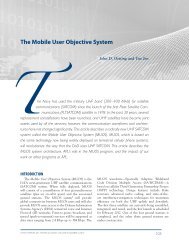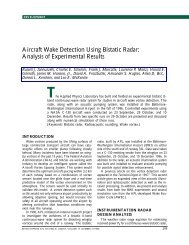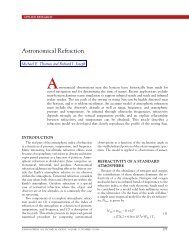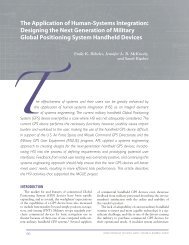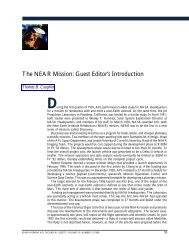The SATRACK System: Development and Applications
The SATRACK System: Development and Applications
The SATRACK System: Development and Applications
You also want an ePaper? Increase the reach of your titles
YUMPU automatically turns print PDFs into web optimized ePapers that Google loves.
satellite trajectory measurements that could be compared<br />
with translator-derived trajectory measurements<br />
for validation purposes.<br />
Transat was launched in October 1977 before any<br />
GPS satellites were available. In early November, the<br />
satellite was checked out in the Transit mode to verify<br />
that it was ready to support operational navigation<br />
users. It was then switched to the Transat mode, <strong>and</strong><br />
initial tests were conducted with the APL pseudosatellite.<br />
Through May 1978, Transat was primarily used<br />
to test equipment at the eastern <strong>and</strong> western test ranges.<br />
<strong>The</strong>se tests provided the capability to check real<br />
system data interfaces using pseudosatellite signals<br />
with an emphasis on range safety system testing. Transat<br />
also proved to be an effective tool for checkout of<br />
the TDMMS. However, validation of GPS tracking<br />
concepts would have to wait until at least two satellites<br />
were available.<br />
In June 1978, the first missile translator flight test,<br />
C4X-17, occurred. Only one GPS satellite was available<br />
for this test, <strong>and</strong> the translator failed after a short<br />
period of operation. However, the test was significant<br />
to the <strong>SATRACK</strong> developers because it was the first<br />
time that we were able to demonstrate that actual<br />
translated GPS signals could be successfully tracked at<br />
the APL postflight tracking facility using data recorded<br />
by one of the range telemetry sites. <strong>The</strong> C4X-18 flight<br />
test in August 1978 was supported by two GPS satellites,<br />
<strong>and</strong> the missile translator worked perfectly<br />
throughout the flight. Since then, translators have<br />
performed successfully on all flight tests. This test<br />
provided the first opportunity to complete a full missile<br />
evaluation with <strong>SATRACK</strong> <strong>and</strong> initiated the first<br />
opportunities for Transat evaluations of the GPS<br />
capabilities.<br />
<strong>The</strong> <strong>SATRACK</strong> processing facility was now operating<br />
at an intense level. Transat validation activities<br />
were just getting started, radar/TDMMS C4 processing<br />
was continuing, normal <strong>SATRACK</strong> C4 processing was<br />
beginning, system validation runs were concluding,<br />
<strong>and</strong> we were first beginning to evaluate the actual<br />
ephemeris accuracy for GPS satellites. <strong>The</strong> original<br />
estimates for these errors reflected into range <strong>and</strong> range<br />
rate uncertainties for each satellite line of sight were<br />
12 ft <strong>and</strong> 0.005 ft/s, respectively.<br />
To directly assess the value of these errors during<br />
each Transat or missile flight test period, data were<br />
collected at an accurately surveyed location. We referred<br />
to this data collecting as “static missile tests.”<br />
<strong>The</strong>se tests provided a direct observation of the link<br />
range <strong>and</strong> range rate errors relative to those computed<br />
from the satellite ephemeris. <strong>The</strong> formal simulation<br />
validation runs were completed in January 1979, <strong>and</strong><br />
a four-satellite Transat validation test was conducted<br />
in March 1979. That Transat test <strong>and</strong> the static missile<br />
results indicated that the GPS ephemeris was not<br />
THE <strong>SATRACK</strong> SYSTEM<br />
providing the expected accuracy. In the early days, we<br />
cross-checked ephemeris data from NSWC with data<br />
from the GPS Master Control Station (the official<br />
system source) <strong>and</strong> with data provided by Aerospace<br />
Corporation. A careful analysis of all the available data<br />
indicated that the GPS ephemeris errors were about 3<br />
times larger than expected for the period covering<br />
C4X-18 (two GPS satellites), C4X-19 (three GPS<br />
satellites), <strong>and</strong> C4X-21 (four GPS satellites) flight<br />
tests. 7 <strong>The</strong> limited number of satellites <strong>and</strong> the largerthan-expected<br />
ephemeris errors were the major difficulties;<br />
all other aspects of the system performed as<br />
expected.<br />
<strong>The</strong> process of evaluating sources of ephemeris<br />
errors continued through the end of 1981; 8 to 10<br />
different software configurations were evaluated.<br />
While this evaluation was being conducted, the initial<br />
baseline ephemeris generation software was being<br />
maintained through all flight tests to that time. However,<br />
in January 1982, a new baseline was selected that<br />
produced an improvement of about a factor of 2. To<br />
maintain consistent processing results, all previously<br />
processed C4 DASO <strong>and</strong> operational test flights<br />
(about 20) were reprocessed with the new baseline<br />
ephemeris generation software. On the basis of the<br />
limitations of the early C4X flight tests, <strong>SATRACK</strong><br />
processing results were compared to radar/TDMMS<br />
results into the early operational tests. 8 After the baseline<br />
was adjusted, C4 trajectory accuracy achieved<br />
with the <strong>SATRACK</strong> I system, based on the first 31<br />
DASO <strong>and</strong> operational flight tests, had a position<br />
uncertainty of 35 ft <strong>and</strong> a velocity uncertainty of 0.09<br />
ft/s at body deployment. 9<br />
Some finer-grain improvements in ephemeris were<br />
subsequently achieved by adding an additional GPS<br />
data collection site at APL, <strong>and</strong> Transat supported<br />
range safety testing as late as May 1982. For the most<br />
part, the <strong>SATRACK</strong> I project was complete, although<br />
translators continue to support all C4 flight tests. In<br />
all, translators have successfully supported range safety<br />
<strong>and</strong> accuracy processing requirements for 154 C4 flight<br />
tests through the end of 1997.<br />
<strong>SATRACK</strong> II<br />
<strong>The</strong> development of the Trident II (D5) missile<br />
began in 1981. To support this development, APL<br />
conducted the Accuracy Evaluation <strong>System</strong> study.<br />
That study supported development of the technical<br />
objectives <strong>and</strong> guidelines document that defined the<br />
accuracy evaluation requirements for the D5 Missile<br />
Flight Test Program. <strong>The</strong> <strong>SATRACK</strong> II requirements,<br />
defined by the Accuracy Evaluation <strong>System</strong> study,<br />
included significant performance enhancements.<br />
It was clear that the D5 requirements could not<br />
be met without a dual-frequency GPS signal tracking<br />
JOHNS HOPKINS APL TECHNICAL DIGEST, VOLUME 19, NUMBER 4 (1998) 443




